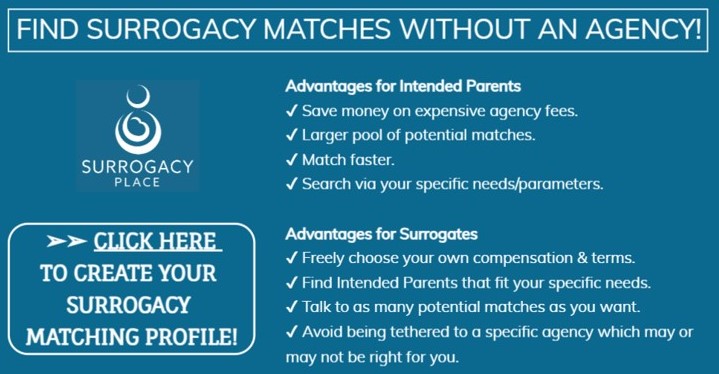After the Journey: Surrogacy Post-Birth Considerations
Keeping in touch: A personal decision
The type of relationship that surrogates and Intended Parents have after the birth of their child can vary widely and depends on various factors, including the specific arrangements made, personal preferences, and the level of communication and trust between the parties involved.
Here are some common scenarios:
Close and Continued Relationship: In some cases, surrogates and Intended Parents maintain a close and enduring relationship after the birth of the child. They may choose to maintain contact, share updates about the child’s growth and development, and even consider the surrogate as an extended member of the family. This typically happens when there is a strong bond of trust and mutual respect between the parties.
Building a close relationship from the start can foster trust and comfort between the surrogate and Intended Parents. This trust can make the entire process smoother, as both parties are more likely to work together harmoniously, share information, and adhere to the terms of the surrogacy agreement. Sharing the pregnancy journey can create unique bonds between the surrogate and Intended Parents. They may celebrate milestones together, attend medical appointments as a team, and experience the joy and anticipation of parenthood as a united front.
Limited Ongoing Contact: Some surrogacy arrangements involve limited ongoing contact between the surrogate and the Intended Parents. This might include occasional updates and pictures of the child, but not necessarily a close ongoing relationship. The level of contact may be determined in advance and specified in the surrogacy contract.
The minimum amount of communication that Intended Parents expect to have with their surrogate during the surrogacy process can vary widely depending on individual preferences, the terms of their surrogacy agreement, and the specific circumstances of the surrogacy journey. There is no universally defined minimum level of communication, as it can be highly subjective and should be established through mutual agreement between the Intended Parents and the surrogate. This includes anticipated post-birth communication and contact.
No Ongoing Contact: In certain cases, surrogates and Intended Parents may choose not to maintain any ongoing contact after the birth. This could be due to personal preferences, privacy concerns, or the terms of their surrogacy agreement.
Intended parents might prefer to not have ongoing contact with the surrogate after their child is born for a variety of reasons, and these reasons can vary from one individual or couple to another. It’s important to remember that each surrogacy arrangement is unique, and personal preferences play a significant role in determining the level of post-birth contact.
Here are some common reasons why Intended Parents and surrogates might prefer no ongoing contact:
Privacy and Boundaries: Some Intended Parents and surrogates value their privacy and prefer to keep their family life separate from their surrogacy arrangement. They may feel that limiting contact helps maintain clear boundaries.
Emotional Closure: For some Intended Parents, the surrogacy journey is a deeply personal and emotional experience. After the birth of their child, they may feel that they have achieved their goal and want to move forward with their lives, focusing on their new family without ongoing reminders of the surrogacy process.
Geographic Distance: In cases where the surrogate lives far away from the Intended Parents, especially where there is a language barrier, maintaining regular contact may be logistically challenging. The geographic distance can make it less practical to have ongoing interactions.
Surrogacy Agreement: The terms of the surrogacy agreement may specify limited post-birth contact, and both parties may choose to adhere to these terms to avoid potential conflicts or misunderstandings.
Prefer Focus on Parenting: Some Intended Parents may simply want to focus on parenting and may feel that ongoing contact with the surrogate could be a distraction from their new responsibilities and the bonding process with their child.
It’s essential to emphasize that the decision to have no ongoing contact with the surrogate should be made with respect for all parties involved and in accordance with the surrogacy agreement and any applicable legal requirements. Clear and open communication between the surrogate and Intended Parents before and during the surrogacy journey is crucial to ensure that everyone’s expectations and boundaries are understood and respected. While some surrogacy arrangements involve limited contact after the birth, it’s essential to handle this aspect of the relationship with sensitivity and empathy.
It’s important to note that while a close relationship can offer benefits, it’s not always necessary for a successful surrogacy journey. Every surrogacy arrangement is unique, and what matters most is that all parties involved are comfortable with the level of relationship they have and that they communicate their expectations and boundaries clearly from the beginning. Some surrogates and Intended Parents may prefer a more limited post-birth relationship, and that’s perfectly valid as long as it aligns with their mutual agreement and legal requirements in their jurisdiction.
Establishing Parentage for Intended Parents
Establishing parentage for children born from surrogacy in the United States is a complex legal process that varies from state to state. Generally, parentage can be established through various types of legal orders, which include:
Pre-Birth Orders
Pre-birth orders are typically issued before the child is born, often during the pregnancy. These orders may be available to Intended Parents in states with favorable surrogacy laws. They legally establish the Intended Parents as the legal parents of the child before birth.
Post-Birth Orders
Post-birth orders are issued after the child’s birth. They can also establish the Intended Parents as the child’s legal parents and may be used in states where pre-birth orders are not available or in cases where the parties prefer to wait until after the birth to complete the legal process.
Second-Parent or Step-Parent Adoption
In some cases, Intended Parents may use second-parent or step-parent adoption to establish parentage when one of them is not biologically related to the child. This is often used in situations involving same-sex couples or when there is a genetic relationship with only one Intended Parent.
Parentage via Adoption:
In rare cases, traditional adoption processes may be used when surrogacy laws are restrictive or ambiguous. This typically involves terminating the surrogate’s parental rights and the Intended Parents adopting the child.
It’s important to note that surrogacy laws and parentage orders vary significantly from state to state in the United States. Some states have clear and favorable laws that facilitate surrogacy and make it relatively straightforward to establish parentage, while others may have restrictive or ambiguous laws, making the process more complex and uncertain. As always, Intended Parents considering surrogacy in the U.S. should seek legal counsel from experienced attorneys who specialize in reproductive law. These attorneys can provide guidance on the specific legal requirements and options available in their state of residence or the state where the surrogacy will take place. Understanding and complying with state-specific surrogacy laws is essential to ensure a secure legal foundation for the parent-child relationship in surrogacy arrangements.
Informing Children of Surrogacy About Their Conception Journey
Telling children that they were conceived via surrogacy is a significant and personal decision for parents. Ultimately, the choice to disclose this information should be made carefully, taking into account personal feelings, child’s best interests, and the family’s unique circumstances. An overwhelming majority of Intended Parents tell their children about their surrogacy journeys.
Here’s some things to consider:
Honesty and Openness: Telling a child about their surrogacy conception promotes honesty and openness within the family. It establishes trust between parents and children, which can be essential for healthy parent-child relationships.
Understanding and Acceptance: Knowing about their surrogacy conception can help a child better understand their unique family story and accept it as a normal part of their identity.
Preparation for Questions: Children are naturally curious, and by providing information about their surrogacy conception from an early age, parents can prepare them to handle questions and conversations about their origins with confidence.
Avoiding Future Shock: Delaying or concealing information about surrogacy can lead to a shock or emotional distress if the child discovers the truth later in life. Being upfront from the beginning can help prevent such situations.
Normalizing Diversity: Surrogacy is one of the many ways families are created, and explaining it to a child can help them appreciate the diversity of family structures and reproductive experiences in society.
Many experts recommend an age-appropriate and gradual approach to discussing surrogacy, with the goal of fostering trust, understanding, and a healthy sense of identity within the family.
FAQ: Surrogacy Post Birth Arrangements
What types of relationships do surrogates and Intended Parents have after the birth of a child?
The type of relationship between surrogates and Intended Parents after a child’s birth can vary widely. It depends on factors such as the specific arrangements made, personal preferences, and the level of communication and trust between the parties involved. Common scenarios include close and continued relationships, limited ongoing contact, and no ongoing contact.
What is the minimum amount of communication expected between Intended Parents and surrogates during the surrogacy process?
There is no universally defined minimum level of communication during the surrogacy process, as it can vary based on individual preferences and the terms of the surrogacy agreement. Communication expectations, including post-birth contact, should be mutually agreed upon between the Intended Parents and the surrogate.
Why might some Intended Parents prefer no ongoing contact with the surrogate after their child is born?
Several reasons may lead to this preference, including valuing privacy and boundaries, seeking emotional closure after achieving their goal, adherence to the surrogacy agreement, and a desire to focus on parenting without distractions.
What are the various types of parentage orders used to establish parentage for children born via surrogacy in the United States?
Parentage orders vary by state and may include pre-birth orders, post-birth orders, second-parent or step-parent adoption, and traditional adoption processes. The specific type of order used depends on the state’s surrogacy laws and the circumstances of the surrogacy arrangement.
Why is it essential to understand and comply with state-specific surrogacy laws when establishing parentage?
Surrogacy laws in the United States vary by state, and understanding and complying with these laws are crucial to ensure a secure legal foundation for the parent-child relationship in surrogacy arrangements. Seeking legal counsel from experienced attorneys is recommended to navigate the legal requirements in a specific jurisdiction.











